人教版新目标七年级英语上册unit6单元教案
- 格式:doc
- 大小:271.50 KB
- 文档页数:12


单元教案Do you like bananas?教材依据:新目标英语七年级上册第六单元教学目标(一)语言知识1、词汇:本单元所要求掌握的所有词汇2、日常交际用语:Do you like …? Yes,I do./No, I don’t.I /They like oranges. I/They don’t like bananas.She likes salad. She doesn’t like salad.3、教学重点:1、掌握各种不同的有关食物方面的名词;2、实义动词like 一般现在时的否定式、疑问式及其答语;3、助动词do /does和don’t/doesn’t的用法;4、一日三餐的营养搭配5、小短文的写作4、教学难点:1、Affirmative and negative statements2、Countable nouns and uncountable nouns3、How to talk about likes and dislikes(二)语言技能学生能认识及听懂各种不同的食物名称,区分可数名词和不可数名词,并能自由表达出自己喜欢和不喜欢的食物;能根据单元所学句型自编对话,讨论自己及他人喜欢和不喜欢的食物并扩展到其他方面(如sports),能进行小组讨论并用英语进行简单的陈述(I like…, I don’t like …,he likes…,he doesn’t like….),能进行一日三餐的营养搭配,能根据课前任务收集和整理资料,并对所得资料进行加工和处理,在课堂中合理地加以运用。
(三)学习策略通过学习课文,掌握有关饮食方面的词汇,并结合所学单词,自由讨论喜好。
通过在课文中交流彼此的特长和爱好,培养群体意识,并在小组讨论及合作中,学会合作学习与研究性学习,完成所给任务,努力开拓课程资源。
(四)情感态度激发学生英语学习的欲望和兴趣,敢于用英语进行交流和表达; 营造情感交融的良好氛围,努力提高学生的学习兴趣,学生自主学习、主动合作;认真完成课前任务,在调查中充分发挥自身潜力,培养思维能力、动手能力、开展研究性学习;(五)文化意识能了解东西方不同的饮食文化。
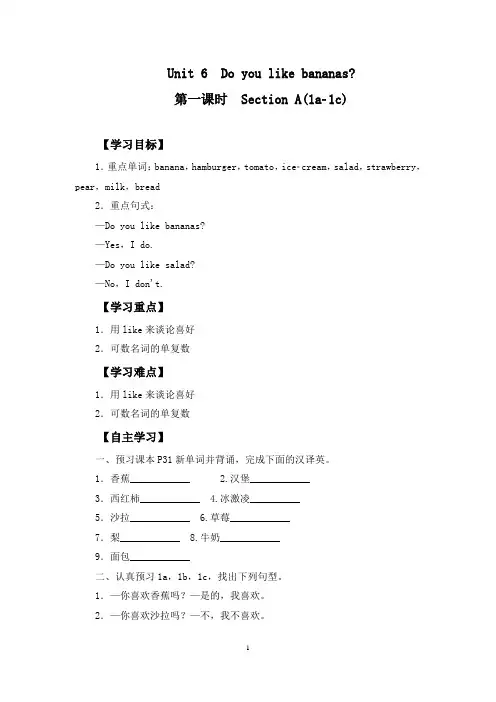
Unit 6 Do you like bananas?第一课时Section A(1a1c)【学习目标】1.重点单词:banana,hamburger,tomato,icecream,salad,strawberry,pear,milk,bread2.重点句式:—Do you like bananas?—Yes,I do.—Do you like salad?—No,I don't.【学习重点】1.用like来谈论喜好2.可数名词的单复数【学习难点】1.用like来谈论喜好2.可数名词的单复数【自主学习】一、预习课本P31新单词并背诵,完成下面的汉译英。
1.香蕉____________ 2.汉堡____________3.西红柿____________ 4.冰激凌__________5.沙拉____________ 6.草莓____________7.梨____________ 8.牛奶____________9.面包____________二、认真预习1a,1b,1c,找出下列句型。
1.—你喜欢香蕉吗?—是的,我喜欢。
2.—你喜欢沙拉吗?—不,我不喜欢。
【课堂导学】Step 1情景导入Teacher:There are many different kinds of fruits and vegetables in the world,and different people like different food.Everyone has its own taste.What kind of food do you like?What kind of food do you dislike?Today let's talk about the food we like and we dislike in Unit 6.环节说明:由学生感兴趣的话题导入新课,简洁明了,激起学生的学习兴趣。
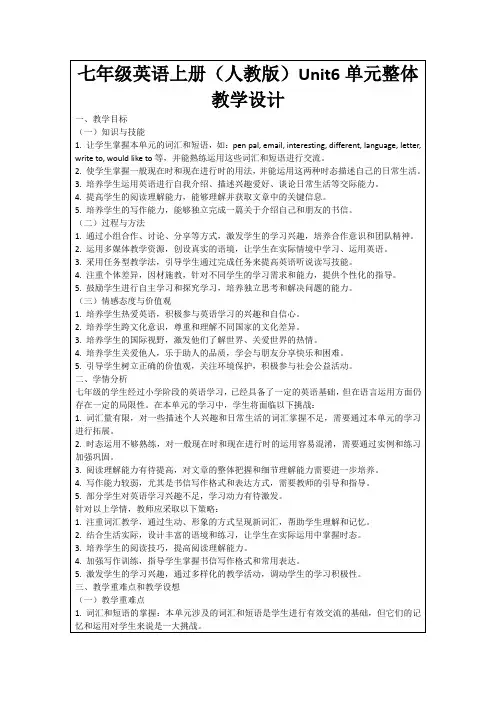
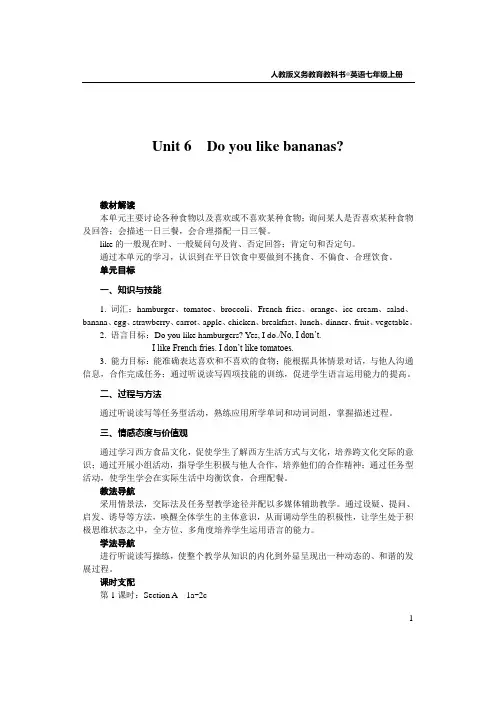
人教版义务教育教科书◎英语七年级上册Unit 6 Do you like bananas?教材解读本单元主要讨论各种食物以及喜欢或不喜欢某种食物;询问某人是否喜欢某种食物及回答;会描述一日三餐,会合理搭配一日三餐。
like的一般现在时、一般疑问句及肯、否定回答;肯定句和否定句。
通过本单元的学习,认识到在平日饮食中要做到不挑食、不偏食、合理饮食。
单元目标一、知识与技能1. 词汇:hamburger、tomatoe、broccoli、French fries、orange、ice cream、salad、banana、egg、strawberry、carrot、apple、chicken、breakfast、lunch、dinner、fruit、vegetable。
2.语言目标:Do you like hamburgers? Yes, I do./No, I don’t.I like French fries. I don’t like tomatoes.3. 能力目标:能准确表达喜欢和不喜欢的食物;能根据具体情景对话,与他人沟通信息,合作完成任务;通过听说读写四项技能的训练,促进学生语言运用能力的提高。
二、过程与方法通过听说读写等任务型活动,熟练应用所学单词和动词词组,掌握描述过程。
三、情感态度与价值观通过学习西方食品文化,促使学生了解西方生活方式与文化,培养跨文化交际的意识;通过开展小组活动,指导学生积极与他人合作,培养他们的合作精神;通过任务型活动,使学生学会在实际生活中均衡饮食,合理配餐。
教法导航采用情景法,交际法及任务型教学途径并配以多媒体辅助教学。
通过设疑、提问、启发、诱导等方法,唤醒全体学生的主体意识,从而调动学生的积极性,让学生处于积极思维状态之中,全方位、多角度培养学生运用语言的能力。
学法导航进行听说读写操练,使整个教学从知识的内化到外显呈现出一种动态的、和谐的发展过程。
课时支配第1课时:Section A 1a-2c1第2课时:Section A 3a-3c第3课时:Section B 1a-2c第4课时:Section B 3a-Self Check课时教案第1课时Section A1a-2c教学目标一、知识与技能1. 掌握基本词汇:food、banana、hamburger、tomato、broccoli、French fries、strawberry、orange、ice cream、salad。

人教版英语七年级上册教案:Unit6 SectionB(2a-2c)Unit6 SectionB(2a-2c)教案【教材版本与册数】新目标人教版七年级上册【单元名称】Unit 6 Do you like bananas?【课时】Section B 2a-2c(第4课时)【课型】Reading(阅读课)教材分析【本单元话题】喜欢和不喜欢(like and dislike)【本单元重点掌握目标】行为动词在一般现在时句子中的使用,应该是上一个单元内容的延伸,通过本单元的教学,学生应初步掌握行为动词一般现在时的肯定句、否定句、特殊疑问句、一般疑问句的构成以及简单的回答和表示食物的可数名词和不可数名词。
【教材内容坼分分析】本单元Section A主要是谈论喜欢和不喜欢(like and dislike),Section B进一步拓展了此话题,按照“听力输入--阅读训练--由读促写”的过程逐层递进。
【通过本单元的学习学生需掌握的综合技能】训练学生的听、说、读、写四项基本技能,学会询问对方与了解别人喜欢与不喜欢的食物,学会谈论自己与他人早、中、晚餐喜爱吃的食物,为其今后能在交际中恰当地表达自己的情感、灵活运用已经学过的常用功能项目、进一步学习并掌握新的语言功能奠定坚实的基础。
第 2 页第 3 页DEL C2 获取新知Step2Reading1. T: Well, let’s see some sports star’s eating habits. Cindy Smith is avolleyball star. What does she like for breakfast, lunch and dinner? Doesshe eat ice-cream? Now let’s r ead the magazine article about Cindy Smith.First, read the article and circle the food words.(Ss read the article and circle the food words quickly.)2.Read the article and fill in the blanks.3. We know Cindy has healthy eating habits. What food does she like? Whatfood doesn’t she like? Read the article and write five sentences aboutCindy’s eating habits. e.g.Cindy likes fruit for breakfast.1.带着问题阅读文章,寻找答案2.再读文章,完成练习学生能够自主阅读文章并寻找答案第 4 页(注意运用句型:Cindy likes … for … 或Cindy doesn’t like/eat … for …)4. Let some Ss read their sentences to the class.5. Then finish 2c.Write five sentences about Ci ndy’s eating habits.Cindy likes healthy food.1. Cindy ___loves fruit.____________________________2. She ____likes oranges and bananas._____________________________3. She _____likes salad for lunch.____________________________4. Cindy doesn’t ___like hamburgers for dinner._____________________5. She doesn’t ___eat ice-cream after dinner._______________________Step3 Language points 1. Sports star eats well!句中的well用作副词,意为“好”,用来修饰动词eat,意为“吃得好”。
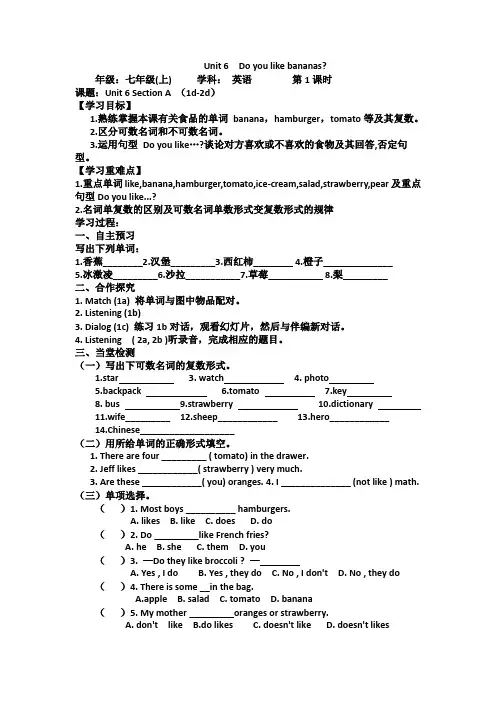
Unit 6 Do you like bananas?年级:七年级(上) 学科:英语第1课时课题:Unit 6 Section A (1d-2d)【学习目标】1.熟练掌握本课有关食品的单词banana,hamburger,tomato等及其复数。
2.区分可数名词和不可数名词。
3.运用句型Do you like…?谈论对方喜欢或不喜欢的食物及其回答,否定句型。
【学习重难点】1.重点单词like,banana,hamburger,tomato,ice-cream,salad,strawberry,pear及重点句型Do you like...?2.名词单复数的区别及可数名词单数形式变复数形式的规律学习过程:一、自主预习写出下列单词:1.香蕉________2.汉堡_________3.西红柿________4.橙子______________5.冰激凌_________6.沙拉___________7.草莓___________8.梨_________二、合作探究1. Match (1a) 将单词与图中物品配对。
2. Listening (1b)3. Dialog (1c) 练习1b对话,观看幻灯片,然后与伴编新对话。
4. Listening ( 2a, 2b )听录音,完成相应的题目。
三、当堂检测(一)写出下可数名词的复数形式。
1.star 3. watch 4. photo5.backpack6.tomato7.key8. bus 9.strawberry 10.dictionary11.wife_________ 12.sheep____________ 13.hero____________14.Chinese___________________(二)用所给单词的正确形式填空。
1. There are four _________ ( tomato) in the drawer.2. Jeff likes ____________( strawberry ) very much.3. Are these ____________( you) oranges.4. I ______________ (not like ) math. (三)单项选择。
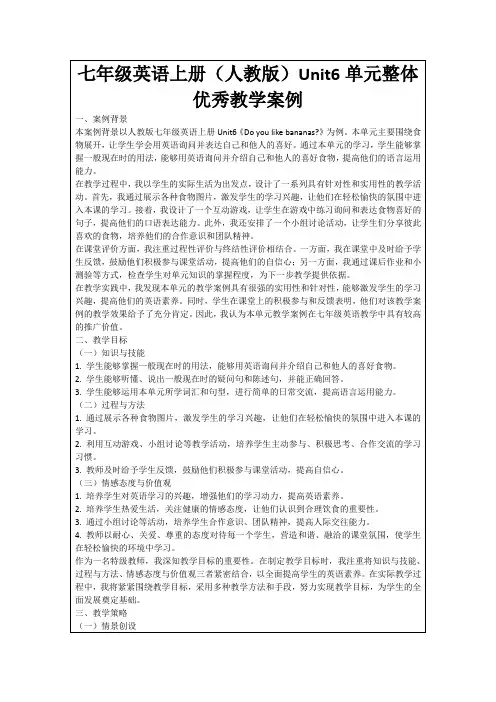
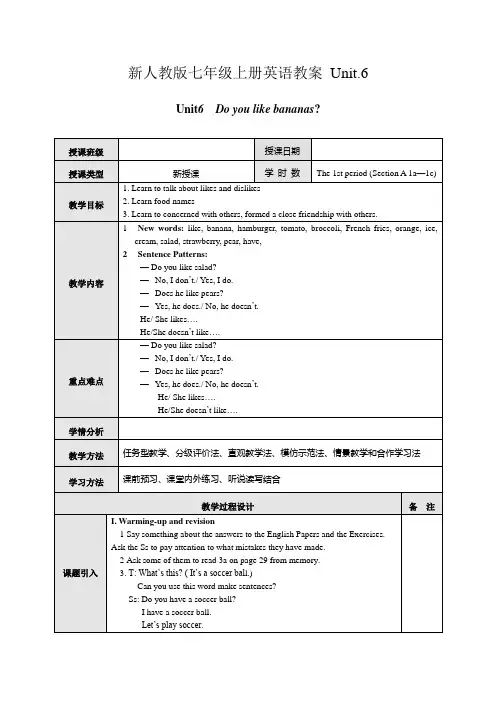
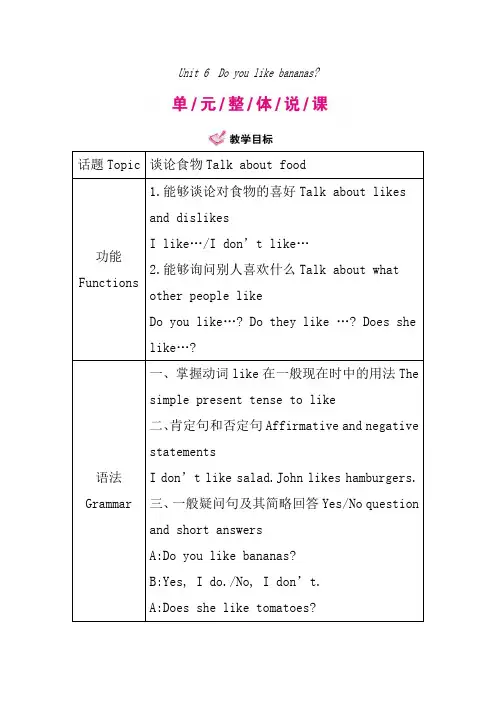
Unit 6 Do you like bananas?话题Topic 谈论食物Talk about food功能Functions 1.能够谈论对食物的喜好Talk about likes and dislikesI like…/I don’t like…2.能够询问别人喜欢什么Talk about what other people likeDo you like…? Do they like …? Does she like…?语法Grammar 一、掌握动词like在一般现在时中的用法The simple present tense to like二、肯定句和否定句Affirmative and negative statementsI don’t like salad.John likes hamburgers.三、一般疑问句及其简略回答Yes/No question and short answersA:Do you like bananas?B:Yes, I do./No, I don’t.A:Does she like tomatoes?与方法在日常生活中运用英语的能力。
2.通过图片提供物体的名称,运用实际例子,感知、学习Do you like…? Yes, I do./No, I don’t. Does he like …? Yes, he does./No, he doesn’t.I don’t like…围绕上面的句型展开操练。
通过调查了解学生们喜欢什么、不喜欢什么,然后在此基础上评价自己和他人的生活是否健康。
情感态度与价值观1.通过任务型活动,使学生们在实际生活中均衡饮食,合理配餐。
2.通过开展小组活动,指导学生积极与他人合作,培养他们的合作精神。
Sectio n A 概述1.本单元主要围绕“谈论对食物的喜好”这一交际功能展开,并以like为例,进一步学习实义动词在一般现在时中的用法,是上一个单元内容的2.活动2让学生使用所学语言谈论自己对不同食物、运动类型以及颜色的喜好。

人教版七年级英语上册Unit6 Do you like bananas教课设计课题Unit 6 Section A 1a /1b /1c /2a /2b.课型New一、知识与技术:1)单词:do,don ’ t,does,doesn’ t,strawberries,like,have,bamburgers,orange,tomatoes,icecream,broccoli,salad,French fries, bananas.2)句型: Do you like bananas?教课目的Yes, I do. \ No, I don’ t.经过学习本课,学生能够用英语相互议论喜爱与不喜爱的食品。
二、过程与方法:1)睁开多种任务型的听力活动,获取理解、辨别和办理与讨论爱好、憎恶有关的信息。
2)经过小组议论、睁开检查等研究,明确在用中学、沟通中学习的想法。
三、感情态度价值观:议论美食,享受生活美味,倡导健康合理饮食。
教课要点掌握对于食品的词汇。
教课难点学会使用社交用语 Do you like bananas? Yes,I do.\ No, Idon ’ t.课前准备录音机、多媒体课件教课过程:设计企图Step1. Warming upStep 2 Presentation经过让学生猜冰箱里有哪些食品的形式,导出新的单词。
同时让全体学生拼读每个单词、让个别学生将单词写到黑板上。
Step3.Task 1部署一项任务:老师手持一个盒子, 让同学猜猜老师最喜爱的食品.规则为学生只好问老师问题而老师只用“Yes”或“No”回答。
达成 Section A, 1a, 1b.Step 4. Task 2部署拓展性任务:要求同桌学生合作编一个小型对话,主题为咨询他人喜爱或不喜爱的食品。
要求使用刚学过的食品类单词以及句型,同时也能够适合地加入课外单词(老师请一程度较好的学生先进行示范)。
Step 5.达成课文32 页 Section A 听力练习activity 2a, 2b.Setp 6.当堂听写听写单词与句型,进一步稳固本课学习内容,并将本课应掌握的单词和句型落实到“写”上,使学生不只会说同时会写。
Unit 6 Do you like bananas?一、单元教材分析本单元的核心项目是“喜欢和不喜欢(like and dislike)”。
围绕着这一中心项目,课文中设计了各种食物及水果的插图和不同形式的表格,让学生进行听、说、读、写等各种学习活动。
通过本单元的教学,使学生学会询问对方与了解别人喜欢与不喜欢的食物,学会谈论自己与他人早、中、晚餐喜爱吃的食物,为其今后能在交际中恰当地表达自己的情感、灵活运用已经学过的常用功能项目、进一步学习并掌握新的语言功能奠定坚实的基础。
本单元的重点内容仍然是行为动词在一般现在时句子中的使用,应该是上一个单元内容的延伸,通过本单元的教学,学生应初步掌握行为动词一般现在时的肯定句、否定句、特殊疑问句、一般疑问句的构成以及简单的回答。
二、单元学情分析本单元的主题是使用动词like询问对方对食物的喜好;谈论自己与他人喜欢吃的食物,学习并掌握行为动词的一般现在时的使用。
通过前一单元的学习,学生已经初步了解了行为动词一般现在时的构成及其使用,再通过本单元学生比较感兴趣的话题的操练,一定会使学生有更深刻的印象;同时教师要善于总结、比较以帮助学生了解构成规律,正确把握所学内容。
三、单元教学建议采用自主学习、小组合作探究、Different opinions和Classifying的学习策略,利用实物、教学图片等来展开课堂pairwork问答式或groupwork讨论式的口语交际活动,使用like询问对方对食物的喜好和谈论自己、他人喜欢吃的食物。
本单元的教学法建议:语音教学——让学生进行模仿操练;词汇教学——采取演示讲解的方式进行教学,让学生进行情景操练、反复使用;口语教学——采取pairwork问答式和groupwork讨论式的口语交际活动互相操练练习;阅读教学——让学生学会抓住主要词汇和句型;听力教学——采取图文配对和对话选择的方式;写作教学——以填空、造句为主;语法教学——比较不同、总结规律、模仿操练。
Unit 6 Do you like bananasUnit 6 Do you like bananas? 教学设计⑥1.复习词汇:like 2.词汇:banana ,hamburger ,tomato ,broccoli ,French fries , orange ,ice cream ,salad ,strawberry ,breakfast ,lunch , dinner ,egg ,apple ,chicken ,fruit ,vegetable3.句型:Do you/they like salad? Yes ,I/they do ./No ,I /they don ’t .Does he/she like salad? Yes ,he/she does ./No ,he/she doesn ’t.I/They like oranges . I/They don ’t like oranges .He/She likes ice cream . He/She doesn ’t like bananas .语法重点:动词like 一般现在时的肯定句、否定句和一般疑问句的用法以及肯定与否定的回答。
Step Ⅱ Exercise 随堂练习设计(1)翻译填空1.你喜欢吃香蕉吗? _______ you __________ bananas?2.艾米丽的哥哥不喜欢吃草莓。
Emily’s brother ________ _______strawberries .3.凯特早餐吃鱼吗? ______ Kate like fish ________ breakfast?4.你晚饭常常吃什么? What _______ you usually have ______ _________?5.我叔叔常常吃冰淇淋作甜食。
My uncle usually ______ ice cream ______ dessert .(2) 用所给词的适当形式填空1. Bob (like) French fries.2. I want some ______(tomato) for dinner3. Would you like some ______(salad)?4. How ______(much) eggs do you have?5. You can see ________ (lot) of pictures in his room.(3) 任务型阅读:根据表格内容完成下面的短文NameJoy Smith AgeFifteenlike SportFoodColoryellowDislike Sport FoodColor red Joy is a boy. He is fifteen years old. His last name is __________. Hoy is his _________ name. He likes to play ___________. He doesn’t like to play __________.。
Unit 6 Do you like bananas?教材解读本单元主要讨论各种食物以及喜欢或不喜欢某种食物;询问某人是否喜欢某种食物及回答;会描述一日三餐,会合理搭配一日三餐。
like的一般现在时、一般疑问句及肯、否定回答;肯定句和否定句。
通过本单元的学习,认识到在平日饮食中要做到不挑食、不偏食、合理饮食。
单元目标一、知识与技能1. 词汇:hamburger、tomatoe、broccoli、French fries、orange、ice cream、salad、banana、egg、strawberry、carrot、apple、chicken、breakfast、lunch、dinner、fruit、vegetable。
2.语言目标:Do you like hamburgers? Yes, I do./No, I don’t.I like French fries. I don’t like tomatoes.3. 能力目标:能准确表达喜欢和不喜欢的食物;能根据具体情景对话,与他人沟通信息,合作完成任务;通过听说读写四项技能的训练,促进学生语言运用能力的提高。
二、过程与方法通过听说读写等任务型活动,熟练应用所学单词和动词词组,掌握描述过程。
三、情感态度与价值观通过学习西方食品文化,促使学生了解西方生活方式与文化,培养跨文化交际的意识;通过开展小组活动,指导学生积极与他人合作,培养他们的合作精神;通过任务型活动,使学生学会在实际生活中均衡饮食,合理配餐。
教法导航采用情景法,交际法及任务型教学途径并配以多媒体辅助教学。
通过设疑、提问、启发、诱导等方法,唤醒全体学生的主体意识,从而调动学生的积极性,让学生处于积极思维状态之中,全方位、多角度培养学生运用语言的能力。
学法导航进行听说读写操练,使整个教学从知识的内化到外显呈现出一种动态的、和谐的发展过程。
课时支配第1课时:Section A 1a-2c第2课时:Section A 3a-3c第3课时:Section B 1a-2c第4课时:Section B 3a-Self Check课时教案第1课时Section A1a-2c教学目标一、知识与技能1. 掌握基本词汇:food、banana、hamburger、tomato、broccoli、French fries、strawberry、orange、ice cream、salad。
2. 掌握句型:Do you like bananas? Yes, I do./No, I don’t.二、过程与方法通过听说读写等任务型活动,熟练应用所学单词和动词词组。
三、情感态度和价值观认识并了解各种食物,能分清水果和蔬菜并能认识到水果和蔬菜对人体有益。
通过询问对方是否喜欢某食物来引起话题。
教学重点基本单词、词汇和句型。
教学难点1. 认识并掌握重点词汇。
2. 能流利地与对方开展关于食物喜好的对话。
教法导航采用任务型教学途径并配以多媒体辅助教学,同时考虑学生的不同层次采取分层递进的教学方法。
学法导航让学生在游戏的情景中感受到轻松愉悦、民主和谐的环境气氛,学生积极主动参与,从而产生了强烈的求知愿望,增强学习兴趣。
教学准备PPT、关于食物的图片。
教学过程Step 1: Greetings.Greet the students as usual.Step 2: RevisionShow the students pictures and ask:What’s this? It’s a soccer ball. Do you have a soccer ball? Yes, I do./No, I don’t. Do you like it? Yes, I do./No, I don’t.Step 3: New wordsShow the students some food and ask:What’s this? It’s a hamburger. Do you like it? Yes, I do./No, I don’t.What a re these? They’re bananas. Do you like bananas? Yes, I do./No, I don’t.运用图片和对话教学单词:hamburger、banana、tomato、broccoli、French fries、strawberry、orange、ice cream、salad,并运用这些单词进行对话。
Step 4: Pair workWork in pairs and try to match the words with the pictures of 1a.Step 5: Listening1b Listen and number the conversations.After listening, show the dialogue on the screen and get the students to practice the conversations, and then make their own conversations.Step 6: ListeningListen and circle the food you hear.First get the students to check their answers in groups and then report their answers.Step 7: Listen againListen again and fill in the blanks.I like hamburgers. Do you like hamburgers? Yes, I do.Do you like______? No, I don’t like ______.Let’s have _______. Oh, no. I don’t like_________.Step 8: Group workMake a food survey in groups by asking: Do you like ...?Then fill in the blanks to complete the form.How many students like hamburgers?How many students like bananas?Step 9: SummaryLet’s sum what we have learned this class.Words:banana, hamburger, tomato, ice cream, salad, strawberry.Sentences:Do you like hamburgers? Yes, I do./No, I don’t.Step 10: Homework1.Remember the words in this class.2.Practise the dialogue in pairs.课堂作业1. 写出下列名词(1) 汉堡 ____________(2) 西红柿 _____________(3) 沙拉 ____________(4) 草莓 ____________(5) 梨 ____________ (6) 牛奶 __________(7) 面包 __________ (8) 冰激凌 _________2. 根据句意完成句子(1) A:_______ you like salad?B:No, I _______./Yes, I ______.(2) I __________(喜欢) hamburgers.(3) _____________ (你喜欢) hamburgers?(4) ____________ (我们吃) strawberries.参考答案:1. (1)hamburger (2)tomato (3)salad (4)strawberry (5)pear (6)milk(7)bread (8)ice cream2. (1)Do, don’t, do (2)like (3)Do you like (4)Let’s教学反思这节课以学生的日常生活为话题,用丰富多彩的实物和图片激发学生的学习兴趣,学生踊跃参加课堂活动,效果很好。
第2课时Section A3a-3c教学目标一、知识与技能1. 掌握词汇:egg、apple、carrot、chicken、fruit、vegetable、breakfast、lunch、dinner。
2. 掌握句型:Does he/she like salad? Yes, he/she does./No, he/she doesn’t.二、过程与方法通过读、练习,小组合作学习,熟练应用所学单词,短语和句型。
三、情感态度与价值观能正确询问他人的喜好。
了解班内同学的喜好,加深同学之间的了解和友谊。
教学重点1. 掌握词汇:egg、apple、carrot、chicken、fruit、vegetable、breakfast、lunch、dinner。
2. 掌握句型:Does he/she like salad? Yes, he/she does./No, he/she doesn’t.教学难点正确询问他人的喜好。
教法导航本课采用任务型教学法,利用图片和口语交际培养学生的学习兴趣和积极性。
学法导航通过小组合作的方式掌握重点单词和句型。
通过班内调查了解同学的喜好。
教学准备设置对话情境;准备调查表。
教学过程Step 1: GreetingsGreet the students as usual.Step 2: RevisionShow some food and ask some pairs to practice the dialogue:Do you like ...? Yes, I do./No, I don’t.Step 3: Lead in(Ask a boy) Do you like bananas? Yes, I do./No, I don’t.(Ask another student) Does he like bananas? Yes, he does./No, he doesn’t.(Ask a girl)Do you like eggs? Yes, I do./No, I don’t.(Ask another student) Does she like bananas? Yes, she does./No, she doesn’t.Step 4: Group workGet the students practice the dialogue in groups of three.Step 5: Make a surveyWork in pairs and ask each other:Does your father/mother/sister/brother ... like ...?Then write down what your family like to eat.My father:eggs, apples ...My mother:chicken, oranges, carrots ...My sister:hamburgers, ice cream ...My brother:...Step 6: Guess gameWork with another student and ask him/her to guess:What does my father like? Does he like vegetables? No, he doesn’t.What does my sister like? Does she like ice cream? Yes, she does.Step 7:Grammar focus1.Do you like bananas? 你喜欢香蕉吗?Yes, I do./No, I don’t.是的,我喜欢。